Shoulder dislocation is a common traumatic injury which can occur during sporting activity or simply as a result of a fall.
A dislocated shoulder occurs when the head of the arm bone separates from the shoulder blade at the shoulder joint. The shoulder joint has great mobility but consequently little stability and is susceptible to dislocation. A subluxation is a partial dislocation of the shoulder.
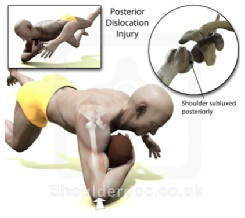
There are different types of dislocation
- 95% are forward - usually caused by a direct blow or a fall backwards or sideways onto an outstretched arm.
- Backward dislocations occur due to seizure or by strength imbalance of the rotator cuff muscles.
- Downward dislocation is very unlikely (<1%).
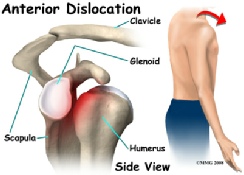
Signs and symptoms
- Significant pain
- Inability to move the arm
- Numbness of the arm
- Visibly displaced shoulder / flattened appearance around the shoulder.
Treatments
Prompt medical treatment should be sought for any dislocation injury to return the shoulder to its normal position.
x-ray will confirm the joint has been replaced into the joint.
Rest in a sling for several days until pain subsides
Mobilise joint soon as the pain allows.
Rotator cuff and deltoid muscle strengthening.
Trauma associated with dislocation disturbs normal activity of muscles around the shoulder blade.
First-time traumatic dislocation have a high rate of labral injury
Surgery may be required following repeated dislocation.
Return to full function and early return to sport or work can be facilitated following treatment and advice from Ennis Physiotherapy Clinic.
‘Tennis elbow’ is a generic term used to describe a tendonopathy which is an overuse injury of the tendons at the outside of the elbow. It may also be called lateral epicondylitis or as a tendonitis if the injury is acute / recent
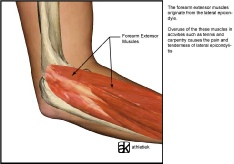
‘Golfers elbow’ is a similar condition affecting the tendons on the inside of the elbow and is also called medial epicondylitis.
Neither is necessarily associated with playing tennis or golf but more with the excessive use of the muscles attached to the bone at the elbow - the wrist extensors affecting the outside and the flexors affecting the inside of the elbow..
It occurs where there is excessive repetitive activity, excessive gripping with the hand or working with the hand in an awkward / poor ergonomic position.
Epicondylitis 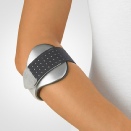 or tendonitis around the elbow responds well to treatment by physiotherapists.
or tendonitis around the elbow responds well to treatment by physiotherapists.
Assessment will determine what the key causative factors are and how they have led to the development of the condition.
Treatment may include:
- Avoiding the provoking activity for a short period
- Soft tissue massage
- Exercises for stretching and strengthening of the affected muscles and other tissues
- Adjusting work and playing postures, adjusting sports equipment Electrotherapy Modalities
- Medications - prescribed by a GP
- A support brace can be worn over the upper part of the affected tendon. This relieves some of the strain + allows ‘rest’.
For a detailed assessment and advice or treatment contact us at Ennis Physiotherapy Clinic.
A broken wrist normally occurs after a fall onto an outstretched hand. The break occurs at the lower end of the bone(s) of the forearm.
The bone fragment may tilt forward (also known as a Smith’s fracture) or backwards which is the more common, Colles fracture.
There is usually obvious distortion of the shape of the wrist, severe pain and minimal active movement is possible. The area can become bruised and swollen within a short period and this can extend into the hand and fingers.
Immediate treatment is with immobilisation within a cast for a number of weeks once the alignment of the bones is corrected.
This followed by a period of rehab during which active use of the wrist + hand are encouraged and a gradual return to normal function.
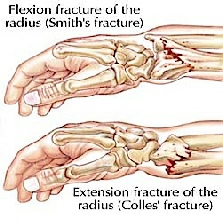
Where there is difficulty with returning to full range of movement or in restoring normal strength and dexterity a patient may be referred for assessment and treatment by chartered physiotherapists.
At Ennis Physiotherapy Clinic we can provide detailed assessment and personalised treatment directed at restoring the maximum amount of normal movement at the joints of the wrist and hand, at reducing any swelling present, at improving pain and functional us.
This will facilitate a return to activities of daily living as soon as possible. This can include work, sport, living or simple leisure activities Back to Top
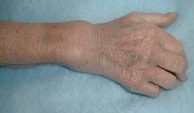
Fracture of the knuckles occurs usually as a result of direct blows or trauma to the rounded lower end of the metatarsal bone, which forms the knuckle of the hand.
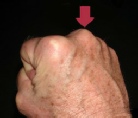 One of the knuckles is usually slightly more prominent when the fist is closed. If a closed fist is struck against something solid the bone can break just behind the rounded end area.
One of the knuckles is usually slightly more prominent when the fist is closed. If a closed fist is struck against something solid the bone can break just behind the rounded end area.
Similarly an open hand is struck directly (ball or a hurley) it can cause a fracture of the bone too.
There is typically bruising and swelling in the hand and fingers, associated with pain and reduced, or minimal, active movement. Depending if there is movement of the fragment the knuckle may become more prominent, or may seem to disappear as it drops below the level of the adjacent ones.
Physioth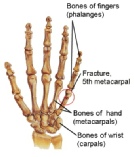 erapy can help to restore normal movement to the joints of the affected fingers and dexterity in the hand in general. For treatment and advice or an assessment
erapy can help to restore normal movement to the joints of the affected fingers and dexterity in the hand in general. For treatment and advice or an assessment
contact us directly at Ennis Physiotherapy
Clinic
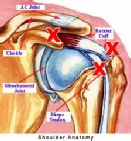 The shoulder joint has a large range of multi directional movement in many planes. Joints that are highly mobile tend to be more unstable. To achieve a high mobility the shoulder depends more on dynamic stability from the rotator cuff muscles around the joint than on the static stability from ligaments.
The shoulder joint has a large range of multi directional movement in many planes. Joints that are highly mobile tend to be more unstable. To achieve a high mobility the shoulder depends more on dynamic stability from the rotator cuff muscles around the joint than on the static stability from ligaments.
Another factor affecting normal shoulder function are position + movement of the shoulder blade, swelling of the AC joint and the shape / orientation of the acromion (bony point of the shoulder).
These affect the risk of developing tendonitis or impingement at the shoulder. Tendons around the shoulder form the ‘rotator cuff’
Tendonitis of the rotator cuff tendons of the shoulder is a common cause of shoulder pain. It is frequently due to overuse (repetitive) or over exertion. It can occur as a secondary issue to poor posture in older people with slouched postures. Repeated use of the arm, at or above shoulder level, can provoke inflammation. A fall onto the hand or elbow or a sudden drag on the shoulder / arm can also provoke acute symptoms.
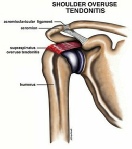 Impingement the tendon can occur at the shoulder between the head of the humerus and the acromion during vigorous, repetitive activity at or above shoulder level.
Impingement the tendon can occur at the shoulder between the head of the humerus and the acromion during vigorous, repetitive activity at or above shoulder level.
The usual movements that cause impingement are a combination of forward flexion to 900 and inward rotation of the arm. Swimmers, throwers, racquet players etc are all at risk.
In older people there are changes within the acromion, the ligaments around the shoulder and the position of the scapula which increase the risk of impingement. The tendons can become inflamed, swell and sore. If this becomes chronic it can cause scarring, weakness and then tearing.
This condition, if chronic, may lead to significantly reduced movement and pain, ultimately possibly ‘frozen shoulder’. It responds slowly but well to conservative treatment including exercise and joint mobilisation. Increased strength, good flexibility of the muscles around the shoulder and postural retraining all help to improve things in the longer term.
For further information and an assessment please contact us at the clinic.
The following video gives an indication of some of the possible exercises that may be suitable for someone with shoulder + rotator cuff problems. An alternative video which has some more basic exercises and an explanation is at this link. These links are for information only and specific advice should be sought from your chartered physiotherapist. Back to Top
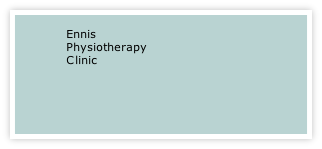




Mon - Fri 9.30am - 8.30pm


3A Barrack Close, Barrack St., Ennis, Co. Clare V95 X437

065 6840757
| Health+Safety Services |
| Sports Clubs+Teams Services |
| Standing Posture |
| Sitting Posture |
| Childhood Posture |
| Using Portable Devices |
| Normal Walking |
| Running |
| Running Drills Videos |
| Muscle Energetics |
| General Fitness |
| Losing Body Weight |
| Gaining Body Weight |
| Weight Loss Programmes |
| Start to Run |
| Start to Swim |
| Start Cycling |
| Start Nordic Waliking |
| Rehab of Tensdons |
| Loading of Tendons |
| Non Specific LBP |
| Posture |
| Intervertebral Disc |
| LBP Treatment |
| Non Specific Neck Pain |
| Neck Care Advice |
| Hamstring Strain |
| Ankle Sprain |
| ACL Injury |
| Joint Replacement |
| Shoulder Dislocation |
| Tennis Elbow |
| Wrist fracture |
| Fractured Knuckle |
| Selecting a Racquet |
| Racquet Grip Size |
| Racuet Sport Injuries |
| Training for Racquet Sports |
| Ski + Board Injuries |
| Injury Videos |
| Injury Prevention |
| Preventing Injury in Musicians |
| Irish Dancing |
| Preventing Dance Injury |